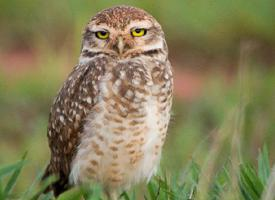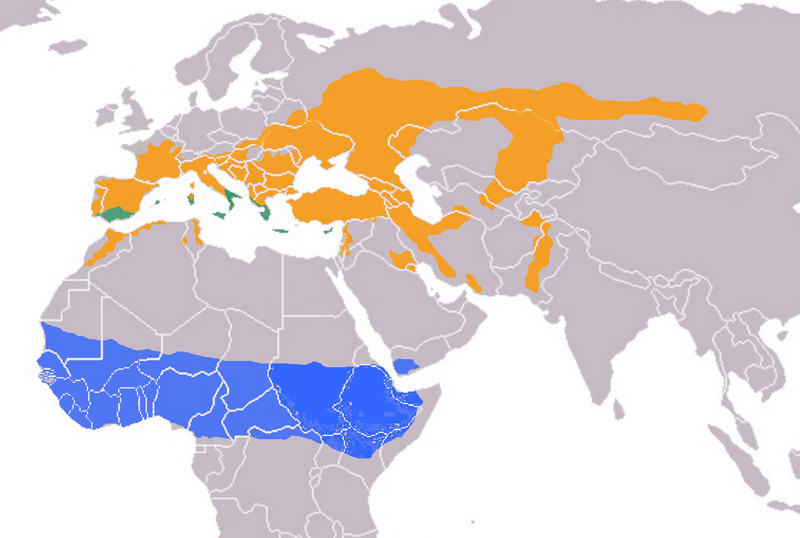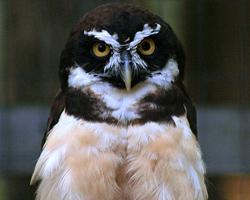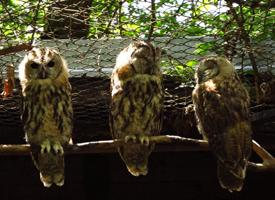
Súlyok és méretek
| Hossz | 25 cm |
|---|
Állatleírás
The Burrowing Owl (Athene cunicularia) is a small, yet distinctive bird of prey that belongs to the Strigidae family, commonly known as owls. Unlike many of its nocturnal relatives, this owl exhibits a preference for a diurnal lifestyle, being active during the day, especially at dawn and dusk. It is easily recognizable by its long legs, sandy-brown plumage, and bright yellow eyes, which give it a captivating appearance.One of the most unique characteristics of the Burrowing Owl is its habitat choice. As its name suggests, this owl is a ground-dweller, favoring open landscapes such as grasslands, deserts, and other arid environments in North and South America. It is particularly notable for its unusual nesting habits, as it occupies burrows excavated by other animals like prairie dogs or ground squirrels, rather than building nests in trees or on cliffs. These burrows are not only used for nesting but also serve as a refuge from predators and extreme weather conditions.
The Burrowing Owl is relatively small compared to other owl species, measuring about 19 to 28 cm (7.5 to 11 inches) in length, with a wingspan ranging from 50 to 61 cm (20 to 24 inches). Its body is compact and its head lacks the ear tufts seen in many other owl species. The bird's plumage is predominantly brown with white and buff spots, which provides excellent camouflage against the ground and its surroundings. Its legs are long and bare, adapted for walking and running on the ground, which is unusual behavior for an owl.
Diet-wise, the Burrowing Owl is a versatile predator. Its diet includes a wide range of invertebrates, such as insects and spiders, as well as small mammals, birds, and reptiles. Its hunting strategy is as versatile as its diet, capturing prey on the wing, on the ground, or even using its burrow as a trap.
The Burrowing Owl plays a significant role in its ecosystem. By utilizing the abandoned burrows of other animals, it contributes to the aeration and turnover of the soil. Furthermore, its diet helps control populations of potentially harmful insects and small rodents.
Despite its adaptability, the Burrowing Owl faces threats from habitat destruction due to agricultural expansion, urban development, and the eradication of burrowing mammals, which indirectly affects the owl's nesting opportunities. Conservation efforts are in place in several regions to protect this unique species, including habitat preservation and the construction of artificial burrows to encourage breeding.
The Burrowing Owl's distinctive characteristics, such as its ground-dwelling habits, diurnal activity, and charismatic appearance, make it a fascinating subject of study and an important species for conservation efforts. Its presence in diverse habitats across the Americas highlights the importance of maintaining ecological balance and protecting the environments that support such unique forms of life.
Előfordulási térkép

Hasonló állatok
Új állatfotók
Top 10 állat
- Dolphin gull (Leucophaeus scoresbii)
- Diana monkey (Cercopithecus diana)
- Moustached guenon (Cercopithecus cephus)
- Stone loach (Barbatula barbatula)
- Greek tortoise (Testudo graeca)
- Galápagos tortoise (Geochelone nigra complex)
- Japanese macaque (Macaca fuscata)
- Russian tortoise (Testudo horsfieldii)
- Common flying dragon (Draco volans)
- Galápagos penguin (Spheniscus mendiculus)


